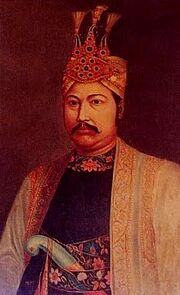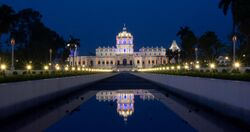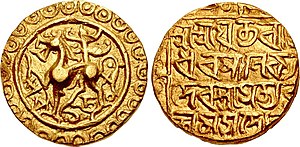History:Twipra Kingdom
Twipra/Tipperah Kingdom | |||||||
|---|---|---|---|---|---|---|---|
| c. Pha dynasty BC to 14 century AD Manikya dynasty 1400 to 1949 AD–1949 | |||||||
| Template:South Asia in 1500 CE Location of the Tripura kingdom and neighbouring South Asian polities circa 1500 CE.[1] | |||||||
| Status | Ancient - Historical kingdom | ||||||
| Capital | Udaipur Agartala | ||||||
| Common languages | Kokborok (Official) Bengali | ||||||
| Religion | Hinduism (Official) | ||||||
| Government | Hereditary monarchy | ||||||
| History | |||||||
• Established by Maha Manikya - founder of Manikya dynasty | c. Pha dynasty BC to 14 century AD Manikya dynasty 1400 to 1949 AD | ||||||
• Reorganisation under Ratna Manikya I | c. 1460 | ||||||
• Joined India | 1949 | ||||||
| |||||||
| Today part of | India Bangladesh Myanmar | ||||||
The Twipra Kingdom (Sanskrit: Tripura, Anglicized: Tippera) was a Tibeto-Burman dynasty ethnic Kingdom of the Tripuri people (Tibeto-burman) in Northeast India.
Geography
The present political areas which were part of the Twipra Kingdom are:
- Barak Valley (Cachar Plains), Hailakandi and Karimganj in present-day Assam
- Comilla, Sylhet and the Chittagong Hill Tracts in Bangladesh
- The present-day states of Tripura and Mizoram[2]
The Twipra Kingdom in all its various ages comprised the areas with the borders:
- The Khasi Hills in the North
- The Manipur Hills in the North-East
- The Arakan Hills of Burma in the East
- The Bay of Bengal to the South
- The Brahmaputra River to the West
Legend
A list of legendary Tripuri kings is given in the Rajmala chronicle, a 15th-century chronicle in Bengali written by the court pandits of Dharma Manikya I (r. 1431). The chronicle traces the king's ancestry to the mythological Lunar Dynasty. Druhyu, the son of Yayati, became king of the land of Kirata and constructed a city named Trivega on the bank of Kapila river. His kingdom was bounded by the river Tairang on the north, Acaranga on the south, Mekhali on the east, Koch and Vanga on the west.[3] The daughter of the King of Hedamba was married to King Trilochona of Trivega. The King of Hedamba, having no heir, made the eldest son of Trilochona the king of his land.[4] After the death of Trilochona, his second son Daksina became King of Tripura. Daksina shared the wealth of the kingdom among his eleven brothers.[5] Being the eldest son of Trilochona, the King of Hedamba demanded his kingdom from his brothers. In denial, the enraged King of Hedamba attacked Tripura and destroyed the capital. The eleven brothers left Trivega and moved to Khalangma on the bank of river Varavakra and found the capital Khalangma.[6] In the 8th century, the kingdom shifted its capital eastwards along the Surma river in Sylhet, near the present-day town of Kailasahar in northern Tripura.[citation needed]
The religion of the Tipra had 14 deities known as Chaturdasa Devata and is still preserved in the Chaturdasha Temple in Agartala, which is maintained by the Tipra priests known as Chantais, who oversee the festivals of the Kharchi and Ker according to traditions.
History
Cheitharol Kumbaba
In Cheitharol Kumbaba chronicles of Manipur, Tripura is referred to as Takhen.[7]
Islamic-invasions era
The earliest historical records concerning the Twipra kingdom appears in the 15th century, when it first came under pressure from the Islamic invaders. This is also the time of origin of the Manikya Dynasty, when Chhengthung Fa adopted the title Manikya, becoming Maha Manikya, with the cognomen being held by all Kings of Tripura until the death of Bir Bikram Kishore Manikya in 1947.[8] Under Ratna Manikya I, the capital shifted to Rangamati on the banks of the river Gumti, now in South Tripura.
Tripura was one of the states that pushed back successive waves of invasions from Turks, Afghans, and Mughals. On many occasions, Tripuris (Tiprasa) also pushed back Burmese and Arakanese invasions from the East. At its height it comprised what is now Tripura, Sylhet division of Bangladesh, Cachar region of Assam state and the Chittagong Hill Tracts of what is now Bangladesh, and even managed to remain free and independent before the British takeover.
The plains of Tripura, however, fell to the attacks from Mughals. The plains territories comprise today's South-East Dhaka and Comilla areas. While the plains areas were thus Islamized, the Hills of Tripura served as a continuous bulwark against penetration to the East. The Tripura Hill Kings were major sponsors of Hindu traditions and customs. In the modern age, they are remembered as one of the longest and most stable dynasties from the Indian East.
Dhanya Manikya (reigned 1463 to 1515) expanded Twipra's territorial domain well into Eastern Bengal. Rangamati was renamed Udaipur after Udai Manikya. The kingdom flourished in the 16th and 17th centuries with kings such as Govinda Manikya putting up a strong defence against the pressure of the Muslim kingdoms to the west. However, the plains areas fell away from Tripura state due to the actions of a renegade Tripuri prince who was backed by Mughal governors of Eastern Bengal plains. After this, plains Twipra became a separate Mughal client kingdom, with the Mughal rulers exerting influence on the appointment of its kings. However, the Mughals could never penetrate the Hills territories to the east.
British India
The princely state of Tripura existed outside British India, in a subsidiary alliance with it, and was a self-governing area known as Hill Tippera, the present-day state of Tripura. However, the kings retained an estate known as Tippera district of the British Bengal Presidency or Chakla Roshanbad, which after the partition of India became part of the greater Comilla region of Bangladesh.
Bir Chandra Manikya (1862–1896) modelled his administration on the pattern of British India, and enacted reforms including the formation of Agartala Municipal Corporation. The last king was Kirit Bikram Kishore, son of Bir Bikram Kishore Debbarma, who ruled for two years, 1947–1949. In 1949, Tripura became part of the Republic of India. The Tripuri "heir apparent" is Kirat Pradyot Kishore Manikya Debbarma (born 1978), the son of the last king, who is sometimes given the courtesy title of "Maharaja".
See also
- History of Tripura
- Tripura (princely state)
- Tripuri people
Notes
- ↑ Schwartzberg, Joseph E. (1978). A Historical atlas of South Asia. Chicago: University of Chicago Press. p. 147. ISBN 0226742210. https://dsal.uchicago.edu/reference/schwartzberg/pager.html?object=185.
- ↑ In 1562, Chilarai attacked the kingdom and took possession of the Barak Valley in which the state of Khaspur was established as a dewani of the Koch kingdom). (Bhattacharjee 1994:71) In the 18th-century, a Kachari king annexed the Hailakandi valley. (Bhattacharjee 1994:72)
- ↑ "Druhyu, the son of Sarmistha, the daughter of Vrsaparvan, became king of the Kirata Land... Druhyu constructed a city in the Trikvega region. His capital was situated on the bank of the River Kapila."(Nath 2020:15)
- ↑ (Nath 2020:32)
- ↑ (Nath 2020:32)
- ↑ (Nath 2020:39)
- ↑ Parratt, Saroj Nalini Arambam (2005). The Court Chronicle of the Kings of Manipur : the Cheitharon Kumpapa : Original Text, Translation, and Notes. London: Routledge. ISBN 0-415-34430-1.
- ↑ (Boland-Crewe Lea)
References
- Nath, NC (February 2020). Sri Rajmala. Tribal Research & Cultural Institute Government of Tripura. https://repository.tribal.gov.in/bitstream/123456789/74658/1/70_Sri_Rajmala_Vol_I_to_IV.pdf.
- Bhattacharjee, J B (1994), "Pre-colonial Political Structure of Barak Valley", in Sangma, Milton S, Essays on North-east India: Presented in Memory of Professor V. Venkata Rao, New Delhi: Indus Publishing Company, pp. 61–85
- Boland-Crewe, Tara; Lea, David (2005). The Territories and States of India. London: Routledge. ISBN 978-1-135-35625-5. https://books.google.com/books?id=M2uPAgAAQBAJ&pg=PA238.
- Tripura Buranji 17th Century Ahom Chronicle.
- Progressive Tripura, 1930
- Rajmala, royal chronicle of Tripura Kings.
- Hill Tippera – History The Imperial Gazetteer of India, 1909, v. 13, p. 118.
Further reading
- Online Books and material
- Tripura Rajmala (1850) by Rev. James Long
External links
- Information on the kingdom of Tripura at the University of Queensland
- About Tippera District Present day Comilla District of Bangladesh
 |





